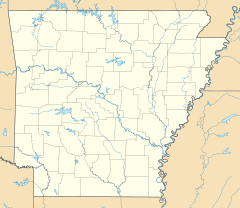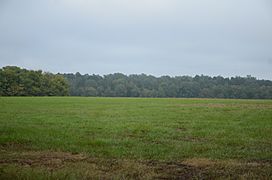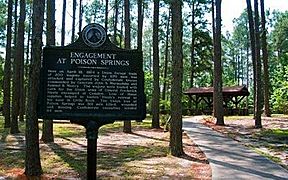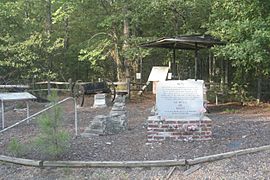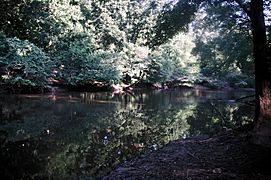Camden Expedition facts for kids
Quick facts for kids Camden Expedition |
|
|---|---|
| Part of the Trans-Mississippi Theater of the American Civil War |
|
| Operational scope | Strategic offensive |
| Location | Southern Arkansas 33°35′N 92°50′W / 33.583°N 92.833°W |
| Commanded by | |
| Objective | Cooperate with Maj. Gen. Banks' movement against Shreveport |
| Date | March 23 – May 3, 1864 |
| Executed by | Department of Arkansas |
| Outcome | Union defeat |
The Camden Expedition was a military operation during the American Civil War. It took place from March 23 to May 3, 1864. This was the last major campaign by the Union Army in Arkansas.
The main goal of the expedition was for Union forces to work together. They wanted to help another Union army led by Major-General Nathaniel P. Banks. Banks' army was moving towards Shreveport, Louisiana, as part of the Red River campaign.
Contents
What Was the Plan?
The U.S. War Department had a big plan. They wanted to take back control of Arkansas, Louisiana, and Texas. This was part of a larger effort to attack Confederate forces in many places at once.
The idea was for different Union armies to destroy Southern troops. They would clear out southern Arkansas and northern Louisiana. Then, they would all meet up for a big push into Texas. This would help end the war in that area.
The part of this plan in Arkansas was called the Camden Expedition. Lieut. Gen. Ulysses S. Grant approved it. The plan was for Maj. Gen. Frederick Steele's army to march to Shreveport. There, they would meet up with another army led by Maj. Gen. Banks and Rear Admiral David D. Porter. This second army was coming up the Red River.
Once they joined, the Union forces would move into Texas. Steele's job was to guard Shreveport. Banks would then go deeper into northeastern Texas. But the two armies never met. Steele's troops faced heavy losses in battles with Confederate forces. These forces were led by Maj. Gen. Sterling Price and Gen. E. Kirby Smith.
The Expedition Begins
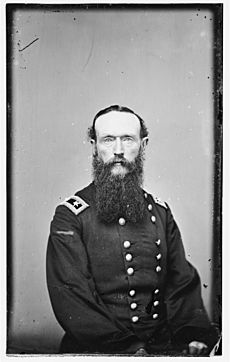

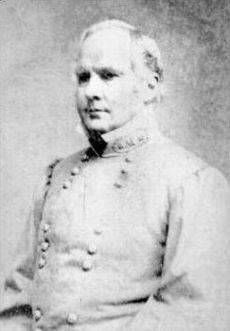
On March 23, 1864, Steele led about 8,500 Union soldiers. They were infantry, artillery, and cavalry. They started from Little Rock. Their goal was to meet Maj. Gen. Banks at Shreveport.
The Confederate government in Arkansas had moved to Washington, Arkansas. Confederate Maj. Gen. Sterling Price ordered Brig. Gen. John S. Marmaduke to bother Steele's army. He wanted to stop them from crossing the Little Missouri River on their way to Washington.
Battle of Mount Elba
To help Steele, Col. Powell Clayton led a raid. He attacked Longview, Arkansas. This was a port on the Saline River. Clayton's cavalry crossed the Saline River at Mount Elba. They quickly defeated a small guard force.
Clayton split his forces. Some went to block a road near Marks Mill. One hundred special soldiers went to destroy a Confederate bridge at Longview. On March 29, these soldiers surprised and captured about 250 Confederate troops. These troops belonged to Brig. Gen. Thomas P. Dockery.
Confederate forces in the area now knew Clayton's raiders were there. They tried to trap Clayton's group by attacking their river crossing at Mount Elba. This happened on March 30, 1864. But Clayton successfully crossed the Saline River again. He defeated the Confederates at the Battle of Mount Elba. Then he returned to Pine Bluff, Arkansas, with over 260 prisoners. This first Union action was a success. However, the rest of the expedition would not go as well.
Battle of Elkin's Ferry
Steele's path was through a wild area with few supplies. He hoped to take Camden, a port city on the Ouachita River, to get more supplies. All the bridges on the Little Missouri River were broken. So, the Union troops had to cross the muddy river by walking through it.
Steele's men reached Elkin's Ferry before the Confederates. But on April 3, Brig. Gen. Joseph O. Shelby's cavalry attacked them. The next day, Marmaduke's cavalry also attacked the Union forces as they tried to cross the river. The Union soldiers fought off both attacks and crossed the river. The Confederates were outnumbered and had to pull back. Maj. Gen. Price set up a defensive position. It was lightly protected by dirt walls. This was on the road between Elkin's Ferry and Washington. It was at the edge of a mostly empty grassy area called Prairie d'Ane.
Battle of Prairie D'Ane
Maj. Gen. Steele waited for more soldiers to arrive. Then he moved forward on April 9. But he was stopped at Prairie D'Ane. This was a series of small fights that ended on April 12. Price's Confederates returned to Prairie D'Ane on April 13. They attacked Steele's rear guard, led by Thayer.
After a four-hour battle, Price pulled back. Steele's army continued towards Camden. Steele pretended to go towards Washington. But then he turned back to Camden. He needed to get more supplies for his army, which was running low on food. Price had moved most of his soldiers out of Camden to defend Washington. So, Union forces took the city on April 15 without much fighting. But they found no supplies waiting for them.
Battle of Poison Spring
After two days, Maj. Gen. Steele sent out groups to find food. He also waited for news from Banks. But Banks was actually retreating. He had been defeated at the Battle of Mansfield. Now, more of Smith's Confederate forces were heading into Arkansas to stop Steele.
Steele's army in Camden was running out of supplies. This forced him to send out a group of 1,200 men to find corn. The Confederates had stored this corn about twenty miles away. The Union group loaded the corn into over 200 wagons. They had gone about 5 miles on April 18. Then, Col. James M. Williams's group was fiercely attacked. The attackers were Marmaduke's and Brig. Gen. Samuel B. Maxey's Confederates. This was at the Poison Spring. Williams had to retreat north into a swamp. His men finally regrouped and went back to Camden. But they lost the wagons full of much-needed corn.
Battle of Marks’ Mills
Steele felt better on April 20 when a wagon train arrived from Pine Bluff with supplies. One week later, the Battle of Marks' Mills happened. In this battle, 2,000 more of Steele's men were captured. Many more wagons were also lost. Steele decided to leave Camden secretly at night. He retreated towards Little Rock on April 26. Three days later, he reached the Saline River at Jenkins' Ferry. He began building a pontoon bridge (a temporary bridge made of floating sections).
Battle of Jenkins' Ferry
Smith's Confederates arrived at Jenkins' Ferry on April 30. They attacked the retreating Union soldiers many times. The weather was windy and rainy. Steele fought off the attacks. He finally crossed the river with what was left of his army. He destroyed the bridge to stop Smith from following. He had to leave most of his remaining supply wagons in the swamp north of the river. A very frustrated Steele finally reached his base at the Little Rock Arsenal on May 3.
What Happened Next?
The Camden Expedition was perhaps the biggest military problem for the Union in Arkansas during the war. Union forces lost over 2,500 soldiers. They also lost hundreds of wagons. They failed to take Shreveport or Texas.
Confederate forces could move freely in rural Arkansas. The Union soldiers stayed inside their forts. These forts were at Fort Smith, Pine Bluff, Helena, and Little Rock.
The Confederate success in Arkansas did have a cost. They might have used their resources better against Porter and Banks. This was when the Union fleet was stuck because the Red River was low. Instead, Porter's fleet was able to escape almost completely.
Protecting the Battlefields
Nine important historical places are connected to the Camden Expedition. They are in Clark, Cleveland, Grant, Hempstead, Nevada, Ouachita, and Pulaski counties in Arkansas. Each of these places is listed on the U.S. National Register of Historic Places.
Together, these sites were named a national historic landmark on April 19, 1994. This means they are very important to the history of the United States.
Image gallery
- Camden Expedition gallery
See also


